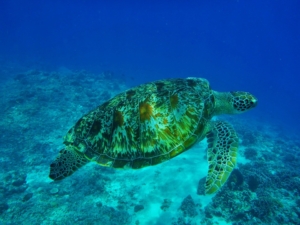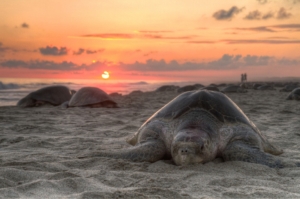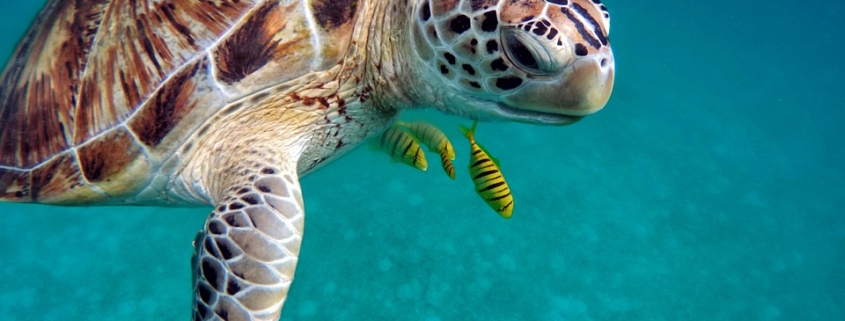The sea turtle is one of the most majestic creatures in the oceans. Featuring a leather-like shell with a retractable head, they have a natural docile disposition. If you’re an avid diver, though, you may have noticed fewer sea turtles in the oceans. Over the past half-century, sea turtle populations have steeply declined, resulting in many species being classified as endangered.
Overview of Sea Turtles
 Also known as marine turtles, sea turtles are marine mammals that, like other turtles, have a hard and leather-like shell. It’s unknown exactly when sea turtles first appeared, though some marine biologists believe they’ve been around for over 110 million years.
Also known as marine turtles, sea turtles are marine mammals that, like other turtles, have a hard and leather-like shell. It’s unknown exactly when sea turtles first appeared, though some marine biologists believe they’ve been around for over 110 million years.
Sea turtles are an important part of marine ecosystems. They consume large amounts of jellyfish, for example, thereby controlling jellyfish populations and preventing overpopulation. According to Oceana, sea turtles also help to maintain coral reefs and seagrass.
Here are some fun facts about sea turtles:
- Sea turtles can grow up to 9 feet long.
- Sea turtle eggs must be incubated for 50 to 60 days in order to hatch.
- When pregnant, a female sea turtle will lay roughly 80 to 120 eggs.
- Once hatched, baby sea turtles will crawl into the ocean from the beach.
- Sea turtles can’t breathe underwater. Rather, they must resurface periodically to avoid suffocation.
- Sea turtles and barnacles have a symbiotic relationship in which they mutually benefit each other.
- It’s not uncommon for sea turtles to migrate thousands of miles.
- Some sea turtles can weigh up to 1,000 pounds.
- Although they are quite smart, sea turtles have small brains compared to the rest of their body.
- Unlike sharks and most fish, sea turtles don’t have teeth.
- The average lifespan of a sea turtle is about 30 to 50 years. With that said, some sea turtles have been known to live for up to 150 years.
- It takes female sea turtles about 20 to 30 years to fully mature.
- Only about one in 1,000 to 10,000 baby sea turtles will survive to reproduce.
- Sea turtles live mostly in isolation. They only come together during the mating season to reproduce.
The 7 Types of Sea Turtles and Their Endangerment Classification
Contrary to what some people believe, not all sea turtles are the same. There are actually seven different species of sea turtles, each of which has unique biological features and behaviors. As a result, some species of sea turtles are less common than others. The International Union for Conservation of Nature (IUCN) — a global organization that tracks wildlife populations and classified them according to endangerment level — has given the following endangerment classifications for the seven species of sea turtles:
- Green Sea Turtle: Endangered
- Loggerhead Sea Turtle: Vulnerable
- Olive Ridley Sea Turtle: Vulnerable
- Hawksbill Sea Turtle: Critically Endangered
- Flatback Sea Turtle: Not Classified
- Leatherback Sea Turtle: Vulnerable
- Kemp’s Ridley Sea Turtle: Critically Endangered
As you can see, with the exception of the flatback sea turtle, all species of sea turtles are either vulnerable or endangered. The U.S. Endangered Species Act (ESA) published an even more grim assessment of sea turtles. In the ESA, all seven species of sea turtles, except for the flatback sea turtle, are classified as endangered. Neither the IUCN nor the ESA has even data on the flatback sea to give it a proper and accurate classification. The evidence is clear, however: Sea turtle populations throughout the world are declining at an alarming rate.
Why Sea Turtles Are Endangered
Several factors play a role in sea turtles’ ever-declining populations. According to the World Wildlife Fund (WWF), overfishing is a primary factor in their endangerment. As the world’s global population increases, the negative impact of fishing on marine life increases as well. Some nefarious individuals fish specifically for sea turtles. Other individuals inadvertently catch sea turtles when fishing for other marine life. Regardless, sea turtles have become endangered partly because of overfishing. Unless countries and coastal communities take action to stop overfishing, their numbers will likely continue to decline.
Another reason why nearly all species of sea turtles are endangered is because of plastic. How does plastic affect sea turtle populations exactly? As previously mentioned, jellyfish is a main source of food for these marine mammals. When plastic bags blow into the sea, sea turtles often mistake them for jellyfish. Of course, sea turtles can’t properly digest plastic bags. They get the plastic bags stuck in their throat or stomach, eventually leading to death.
How to Find Sea Turtles When Diving
Even with their dwindling populations, there are a few things you can do to increase your chances of encountering a sea turtle when diving. First and foremost, choose a location to dive where sea turtles are common. The Great Barrier Reef in Australia is well-known for its large and healthy populations of sea turtles. Other locations where sea turtles are common include Maui Island in Hawaii and Sipadan in Malaysia.
Another tip to increase your chances of spotting sea turtles is to dive shallower depths. Sea turtles can go pretty deep. In fact, leatherback sea turtles have been known to dive to depths of up to 4,200 feet. Whether it’s a leatherback, green, loggerhead or any other species, however, all sea turtles must resurface periodically for air. Therefore, you are more likely to encounter these marine mammals when diving at shallower depths.
What to Do If You Encounter a Sea Turtle in the Ocean
 When you cross paths with a sea turtle in the ocean, remember to look but not touch. Many divers feel compelled to touch these majestic marine mammals. After all, it’s not everyday that you can encounter a sea turtle when diving. While reaching out to touch a sea turtle’s shell may sound harmless, though, it isn’t a good idea. If a sea turtle feels threatened by your presence, its natural instinct may kick in prompting it to bite you. Sea turtles don’t have teeth, but they do have sharp beaks that cause serious and painful injury.
When you cross paths with a sea turtle in the ocean, remember to look but not touch. Many divers feel compelled to touch these majestic marine mammals. After all, it’s not everyday that you can encounter a sea turtle when diving. While reaching out to touch a sea turtle’s shell may sound harmless, though, it isn’t a good idea. If a sea turtle feels threatened by your presence, its natural instinct may kick in prompting it to bite you. Sea turtles don’t have teeth, but they do have sharp beaks that cause serious and painful injury.
Assuming you have a waterproof camera, you should use this opportunity to take a photo of the sea turtle. It’s perfectly fine to take photos of sea turtles as long as you don’t touch them.
What to Do If You Encounter a Sea Turtle on the Beach
You may encounter sea turtles on the beach as well. Pregnant sea turtles, for example, will walk ashore several times each season to lay eggs. If you happen to stumble upon a sea turtle while traversing a beach, try to stay as far away as possible. If you get too close, you may scare the sea turtle back into the sea. And assuming it’s a pregnant sea turtle that’s trying to give birth, she may not return to finish laying all her eggs. By keeping a safe distance, she can lay all her eggs in peace, which in turn increases the number of sea turtles in the oceans.
Pregnant sea turtles typically lay eggs during the cover of night. Unfortunately, this had led some beach-goers to shine flashlights on nesting sea turtles. The problem with flashlights, though, is that they often scare nesting sea turtles. If you happen to shine a flashlight on a nesting sea turtle, she may go back into the ocean without laying or incubating all her eggs.
Grab your deeply cool diving log book with the incredible turtle design today!



